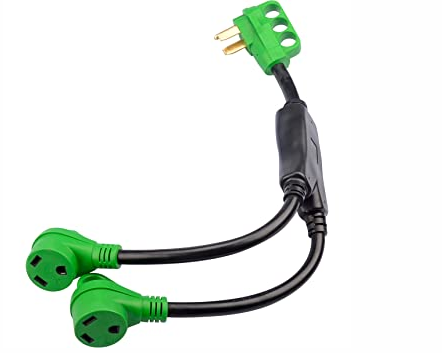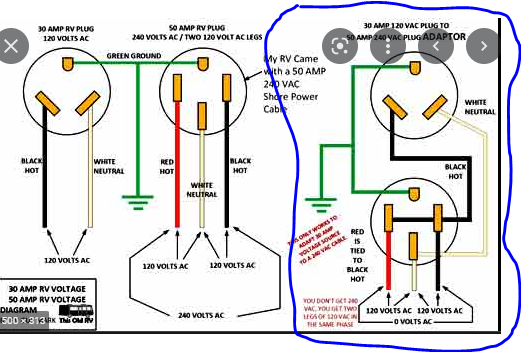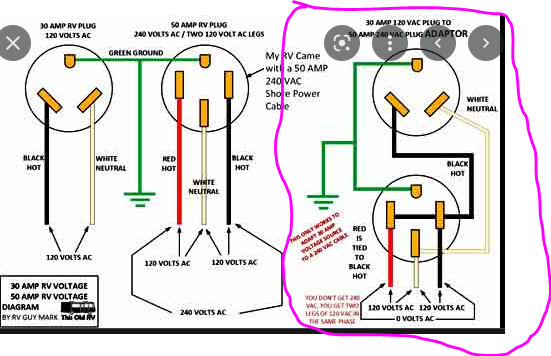If they are rated for 30 amps then it would not be safe to pull 50 amps out of each one. The rating is THE RATING. Besides each trailer with a 30 amp service should have a 30 amp master or main breaker inside the converter panel.
You are using an out of date browser. It may not display this or other websites correctly.
You should upgrade or use an alternative browser.
You should upgrade or use an alternative browser.
50 amp rv plug into 30 amp receptacle
- Thread starter Martian
- Start date
The friendliest place on the web for anyone with an RV or an interest in RVing!
If you have answers, please help by responding to the unanswered posts.
If you have answers, please help by responding to the unanswered posts.
- Status
- Not open for further replies.
Martian
Well-known member
The 50 amp plug to two 30 amp sockets are not a question. It is the 30 amp plug to the 50 amp outlet that is in question. It appears that the two legs tie together but no sites give that info. Might need a trip to the local rv supply shop with a multimeter to verify. Neither rig will be drawing much. A converter to charge the batteries and a reefer in each one. The radio presets and propane detectors are not much. The cables going into each are the normal cables on the units.
Contributor
Well-known member
- Joined
- Jul 9, 2022
- Posts
- 1,423
Any chance you could get away with one RV on the 50A plug and and an extension cord from the 50A RV to the other with a plug adaptor?
NY_Dutch
Well-known member
Except that in the case presented, one of the RV's is wired for 50 amp service, so there is no 30 amp breaker anywhere between the source and load.If they are rated for 30 amps then it would not be safe to pull 50 amps out of each one. The rating is THE RATING. Besides each trailer with a 30 amp service should have a 30 amp master or main breaker inside the converter panel.
NY_Dutch
Well-known member
If the wire and contacts are capable of handling 50 amps, then of course they can handle it. Is it possible the wiring and 30 amp outlets are of capable handling a continuous 50 amps? Not likely. There is usually some safety over rating built in to electrical devices, but just how much over rating is an unknown.My question is really about the 30-amp RV outlets themselves. Can they safely handle 50 amps (if the wire to them can). And if so, can it be a continuous 48 amps?
I assume it's probably not much of an issue as long as there is no juice when plugged in and removed as long as it's a good connection when used.
I just am not sure what the rating means--or even if the rating on a plug/outlet is really the max current it can handle, even if off when plugged in or out.
-Don- Reno, NV
DonTom
Well-known member
That's a good point. If it is used as intended, you're not going over the 30-amps anyway.Besides each trailer with a 30 amp service should have a 30 amp master or main breaker inside the converter panel.
A problem before the RV is rather unlikely and that is the only place where the 50-amp draw is possible.
-Don- Reno, NV
DonTom
Well-known member
I assume there are many variables besides the current. Such as if there is a load when plugged in and unplugged, weather, dampness, how clean the contacts are, etc. & all of it is taken into consideration with the rating.Not likely. There is usually some safety over rating built in to electrical devices, but just how much over rating is an unknown.
-Don- Reno, NV
DonTom
Well-known member
Are you planning on using TWO adapters in series to do such?One is 30 amp and the other is a 50 amp setup
-Don- Reno, NV
NY_Dutch
Well-known member
Yes, the 30 amp RV will plug into the 'Y' adapter directly and the 50 RV will plug in via a 30/50 adapter.Are you planning on using TWO adapters in series to do such?
-Don- Reno, NV
DonTom
Well-known member
Which brings back the safety issue I mentioned. But as long as not going over 30 amps total on the 50-amp RV, no issue.Yes, the 30 amp RV will plug into the 'Y' adapter directly and the 50 RV will plug in via a 30/50 adapter.
-Don- Reno, NV
Martian
Well-known member
To end the speculation of safety, there will probably be no more than 25 amps total draw on the 50 amp circuit. Thus, I am not concerned about the safety of the setup, just whether the 50 amp to 30 amp dogbone feeds both legs of the unit that has the 50 amp plug. To answer another question, no, there is no possibility of plugging the 50 amp directly and using an extension cord to the other as the nearest 20 amp outlet is 350 feet away on the other side of an active road.
Contributor
Well-known member
- Joined
- Jul 9, 2022
- Posts
- 1,423
I was thinking that if the RVs are next to each other, have one RV feed the other with a short extension cord. The issue is then which 120 outlet to use in the provider RV, outside one or inside one. The inside one requires creativity, the outside one if weatherproof should be OK.
I would do what you are doing exactly. Just putting it out there as an option for those concerned about the CB not tripping in a overload protection. What I suggested as an alternative would have a CB in the RV supplying the second one protecting for overloading the wiring.
I would do what you are doing exactly. Just putting it out there as an option for those concerned about the CB not tripping in a overload protection. What I suggested as an alternative would have a CB in the RV supplying the second one protecting for overloading the wiring.
Last edited:
John From Detroit
Well-known member
If I had a 30 amp Rig I'd get the 50 to dual 30 aeapter for sites where I can use it
Since I have a 50 amp rig I carried a full set of adapters
50 - 30 (It does bridge the two legs so both legs get power but pay attention to how much you use or you get to reset the park breaker frequently)
And 30-50 Because my old trailer was 30 and I still had 'em.. plus some places I never knew when I'd have to loan out an adapter.
Since I have a 50 amp rig I carried a full set of adapters
50 - 30 (It does bridge the two legs so both legs get power but pay attention to how much you use or you get to reset the park breaker frequently)
And 30-50 Because my old trailer was 30 and I still had 'em.. plus some places I never knew when I'd have to loan out an adapter.
Ex-Calif
Well-known member
Simple answer is yes.
In this case you probably have one of these adapters?
View attachment 157925
You may have each 30A plug on a separate 50A leg but I would have to check it with a meter to be sure. If you measure between the hot pins of each 30A plug it will show 240V if on separate legs or 0V if they share the same leg. Either way, if all you want is to keep the batteries up and possibly use a few lights it should work as a shared leg would still allow about 15a each. If it is on separate 50a legs the RV limit for the 30A RV will be it's own main power circuit breaker.
Logically and engineering-wise - for the American consumer - the 30 amp females would be on separate 50 amp legs. Otherwise Joe America could not plug in 2 X 30amp RVs which is the logical intended purpose of this splitter.
Kind of an expanded way of saying I agree with DonTom that we have to protect the consumer from himself.
Ex-Calif
Well-known member
Electrically if you plug the green splitter into a 50amp outlet and one 30amp female into a 30amp RV, that's fine. 30 amp protection at the RV and 50amps on the leg.
If you plug a 30 to 50amp dogbone into the 50amp RV you will get 120V on each leg sharing a 50amp feed. There is nothing to control the balance of load so in theory you could draw 50 amps through one leg of the 30/50 dogbone.
For running the power converters on 2 RVs this should be fine. I expect the 50 amp park panel will blow if the 50amp RV turns on more than one A/C.


If you plug a 30 to 50amp dogbone into the 50amp RV you will get 120V on each leg sharing a 50amp feed. There is nothing to control the balance of load so in theory you could draw 50 amps through one leg of the 30/50 dogbone.
For running the power converters on 2 RVs this should be fine. I expect the 50 amp park panel will blow if the 50amp RV turns on more than one A/C.


Attachments
NY_Dutch
Well-known member
Each 30 amp leg of the adapter is fed from a separate 50 amp leg from the source. A single 50 amp 6,000 watt leg will support two A/C units without tripping the breaker.Electrically if you plug the green splitter into a 50amp outlet and one 30amp female into a 30amp RV, that's fine. 30 amp protection at the RV and 50amps on the leg.
If you plug a 30 to 50amp dogbone into the 50amp RV you will get 120V on each leg sharing a 50amp feed. There is nothing to control the balance of load so in theory you could draw 50 amps through one leg of the 30/50 dogbone.
For running the power converters on 2 RVs this should be fine. I expect the 50 amp park panel will blow if the 50amp RV turns on more than one A/C.
View attachment 157933
View attachment 157934
Kirk
Well-known member
If you use that device to split a 50A outlet that has the typical 2 ganged cricuit breakers supplying it and then you use a 50/30a adapter at each 30A plug to connect a 50a RV to each of the plugs, the wire and connections of the splitter become the limiting factor since there is now on 30A protection for wire sized for only 30a. You might get away with doing this with only 1 drawing more than 30a at least for a time but if both sides push the 50a limit the splitter will most likely get hot enough to melt it.So you're saying it's okay to draw 50 amps out of a 30-amp adapter outlet without any CB tripping?
No common circuit breaker is designed to operate at the upper current limit continously. The actual design of circuit breakers is that they have a long-time limit that is usually about 80% of the stated limit, a short-time limit that is typically 120% of the stated limit and an instantanious trip point that is typically 150% or more of the stated limit. The higher one allows for surge currents of a starting motor and similar things.My question is really about the 30-amp RV outlets themselves. Can they safely handle 50 amps (if the wire to them can). And if so, can it be a continuous 48 amps?
It is difficult to say exactly what current level will cause a 30a device to fail, only that 30a or less will not fail. The failure point will depend on things like the condition of the device, the wire sizes used, how tight connections are and a host of other things. I would be very surprised if you could draw even 35a from a 30a rated outlet continously without melting it or some other failure.
Anyone who used one of the 50/30a splitter devices with adapters on the one or both of the 30a plugs to power a 50a RV is taking a risk of overloading it and causing harm to the splitter. The first hint would usually be that it would get hot but while is the most likely thing that would happen if overloaded, there are many other possibilities. Those splitters should really have a current limiting device installed into them for 30a or use wire that is sized for the 50a potential. To know what it has would require more information that I have seen on them, or I would need to cut it apart and measure things like wire sizes.
If you have not done so, you should feel of the power cord and plug of your RV when using heavy loads. Even in cool weather the use of air conditioning will usually cause the RV power cord to be warm to the touch. It should never be too hot for you to hold in your hand as that is an indication that it is either overloaded or there is a developing problem in the cord or plug. Over time most RV plugs beging to get discolored or even show signs of melting around the pins of the plug. When that happens it means you should consider replacing the plug. A badly weathered outlet that your plug slips in and out of very easily will probably be loose enough for some arcing to take place and that will heat up your plug and damage it.
Ex-Calif
Well-known member
That's what I said.Each 30 amp leg of the adapter is fed from a separate 50 amp leg from the source. A single 50 amp 6,000 watt leg will support two A/C units without tripping the breaker.
But f you are referring to my comment about running 2 A/Cs off one 50 amp leg, I didn't state it but you also have to consider the other A/C loads that are typical on a 50amp RV like water heater, converter/charger & fridge which are continuous loads unless they are shut off. Those 3 are probably 20amps combined.
But your point is taken. If nothing else running you could likely run 2 A/Cs.
I have another concern regarding this discussion. If using a 30 amp post outlet to a dogbone to connect a 50 amp RV service, I find nothing wrong with this approach. The circuit is protected by the 30 amp breaker on the power post and the associated components downstream are rated at a higher current. That's OK.
HOWEVER, if using the 50 amp power post outlet with a Y cable shown in #7 and #35 above, I then am concerned that the 30 amp hardware, namely the female outlets on the Y, the male plugs into the outlets, and the #10 ga. wire to the RV is rated at 30 amps, but they are protected by a 50 amp breaker in the power post. This does not comply with the NEC (National Electrical Code) I view it as an unsafe application. Yes, I realize the RV has a 30 amp breaker inside to protect the system internally, but what about externally? The components are 30 amp rated but protected by 50 amp breakers. Not OK.
Oh, I know folks do it, and I know "it works", but it is not safe, nor is it legal.
HOWEVER, if using the 50 amp power post outlet with a Y cable shown in #7 and #35 above, I then am concerned that the 30 amp hardware, namely the female outlets on the Y, the male plugs into the outlets, and the #10 ga. wire to the RV is rated at 30 amps, but they are protected by a 50 amp breaker in the power post. This does not comply with the NEC (National Electrical Code) I view it as an unsafe application. Yes, I realize the RV has a 30 amp breaker inside to protect the system internally, but what about externally? The components are 30 amp rated but protected by 50 amp breakers. Not OK.
Oh, I know folks do it, and I know "it works", but it is not safe, nor is it legal.
Gary RV_Wizard
Site Team
My question is really about the 30-amp RV outlets themselves. Can they safely handle 50 amps (if the wire to them can). And if so, can it be a continuous 48 amps?
Assuming the outlet or adapter actually has an industry-standard rating, that means it was tested in a lab to handle a peak of 30A for at least 30 minutes and a continuous amperage at 80% of peak (24 amps) for at least 4 hours. [I'm not positive of the 4 hours but it is in that ballpark.] It may be able to do more than that and the better quality units very likely can, but it promises to meet the rating standard as a minimum.
Given that manufacturer lawsuits are so common and expensive, I feel confident that the outlets used in the adapter probably meet the industry standard definition of "30A". At least when new. But since it it is also a given that Americans near-always buy the cheapest rather than the best, I would not want to gamble that the adapter has any capacity above & beyond minimum requirements.
- Status
- Not open for further replies.

